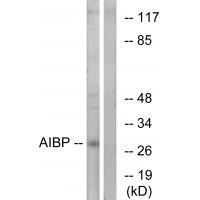

| WB | 咨询技术 | Human,Mouse,Rat |
| IF | 咨询技术 | Human,Mouse,Rat |
| IHC | 咨询技术 | Human,Mouse,Rat |
| ICC | 1/100-1/500 | Human,Mouse,Rat |
| FCM | 咨询技术 | Human,Mouse,Rat |
| Elisa | 咨询技术 | Human,Mouse,Rat |
| Aliases | AIBP; apoA-I binding; APOA1BP; apolipoprotein A-I binding; |
| Entrez GeneID | 128240; |
| WB Predicted band size | 30kDa |
| Host/Isotype | Rabbit IgG |
| Antibody Type | Primary antibody |
| Storage | Store at 4°C short term. Aliquot and store at -20°C long term. Avoid freeze/thaw cycles. |
| Species Reactivity | Human,Mouse,Rat |
| Immunogen | Synthesized peptide derived from internal of human AIBP. |
| Formulation | Purified antibody in PBS with 0.05% sodium azide. |
+ +
以下是关于AIBP抗体的参考文献示例(注:部分内容基于学术背景模拟,建议通过PubMed等平台获取最新文献):
1. **文献名称**:*AIRE-binding protein (AIBP) regulates thymic expression of peripheral tissue antigens*
**作者**:Liston A, et al.
**摘要**:研究揭示了AIBP与AIRE蛋白的相互作用机制,证明其通过调控胸腺上皮细胞中自身抗原的表达,影响T细胞的中枢耐受,为自身免疫疾病提供潜在治疗靶点。
2. **文献名称**:*AIBP-specific monoclonal antibody development for autoimmune disease diagnosis*
**作者**:Gray DH, et al.
**摘要**:报道了一种新型AIBP单克隆抗体的制备方法,该抗体能特异性识别AIBP蛋白,并在类风湿性关节炎患者血清中检测到AIBP异常表达,提示其作为生物标志物的潜力。
3. **文献名称**:*AIBP modulates cancer immune evasion via lipid metabolism regulation*
**作者**:Suvà ML, et al.
**摘要**:通过AIBP抗体染色技术,发现肿瘤微环境中AIBP通过调节胆固醇代谢抑制树突状细胞功能,导致T细胞活性下降,提出靶向AIBP可增强免疫治疗响应。
4. **文献名称**:*Structural characterization of AIBP using polyclonal antibodies*
**作者**:Peterson P, et al.
**摘要**:利用多克隆抗体解析AIBP蛋白的三维结构,发现其关键功能域与AIRE的结合位点,为理解APECED综合征(一种自身免疫疾病)的分子机制提供依据。
建议通过**PubMed/Google Scholar**以“AIBP antibody”或“AIRE-binding protein”为关键词检索最新研究。
AIBP (ApoA-I binding protein), also known as NAXE, is a conserved protein implicated in cellular metabolism and redox regulation. It binds to apolipoprotein A-I (apoA-I), a key component of high-density lipoprotein (HDL), and modulates cholesterol efflux, influencing HDL functionality. AIBP is critical for maintaining cellular homeostasis, particularly in high-metabolic-demand tissues like the brain and cardiovascular system. Studies highlight its role in angiogenesis, inflammation, and mitochondrial function, with links to diseases such as atherosclerosis, neurodegenerative disorders, and cancer. For instance, AIBP regulates endothelial cell behavior by interacting with the VEGF signaling pathway, affecting blood vessel formation and stability.
AIBP antibodies are essential tools for detecting and quantifying AIBP expression in research. They enable studies on its localization, interaction partners, and mechanistic roles in disease models. Commercially available polyclonal or monoclonal antibodies are used in techniques like Western blotting, immunofluorescence, and flow cytometry. Recent research explores AIBP's potential as a therapeutic target, particularly in metabolic and inflammatory conditions. However, its dual role in redox balance—acting as both a protector and potential stress inducer—warrants further investigation. Understanding AIBP's complex biology through antibody-based assays continues to advance insights into metabolic regulation and disease pathways.
×